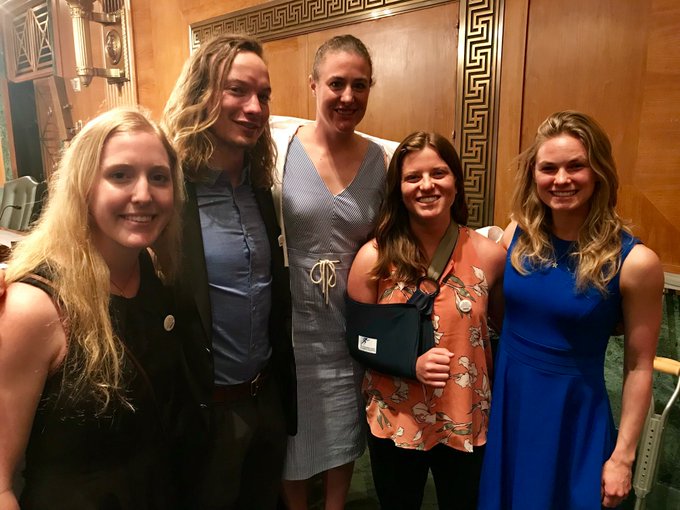Winter Olympians give Congress an economics lesson on climate change
“When winters warm up and continue to do so, our sport is going to disappear.”

Five U.S. Winter Olympians traveled to Capitol Hill on Wednesday to talk about an issue of grave importance to their sports: climate change.
“I’m really worried about the future of our sport,” Jessie Diggins, a 2018 gold medalist in cross country skiing, said. “When winters warm up and continue to do so, our sport is going to disappear. It’s heartbreaking.”
The event, co-hosted by Sens. Michael Bennet (D-CO) and Susan Collins (R-ME), sought to draw a connection between winter sports and climate change that athletes witness regularly, but rarely talk about outside of their own circles.
As global temperatures continue to rise, things like snowpack, precipitation, and even the length of seasons are beginning to shift — something that threatens not just the future of winter sports, but the economic lifeblood of mountain communities that depend on the winter recreation economy.
Throughout the United States, winter temperatures — measured from December to February — have increased by an average of 0.55 degrees Fahrenheit per decade since the 1970s. At the same time, snowpack has decreased across much of the country; according to a March study from Oregon State University, North America’s snowpack has declined by up to 30 percent in the last century.
This winter season began with months of below-average snowfall for states across the West thanks to a combination of above-average temperatures and below-average snowfall. Colorado was particularly hard-hit by the snow drought, with snow levels hitting a 30-year low in early February (levels have since rebounded slightly, though not enough to produce an average season).
Low snow levels, which translate to a delayed start to the winter tourism season, can have a profound impact on the economy of mountain communities or local businesses that depend on winter recreation. This year in Colorado, for instance, Aspen Skiing Co. — which normally employs seasonal workers for a number of mountains in the state — opened a soup kitchen for employees who couldn’t find work due to low snow levels.
“Global warming is already impacting us all economically, and it is going to continue to do so,” said David Wise, who won the gold medal in the PyeongChang Winter Olympics in freestyle skiing. “It’s not just about protecting the environment anymore. It’s about the economy too.”
Beyond issuing warnings about how climate change might impact winter economies, the athletes also took time to share their concern about what rising temperatures might mean for the future of the sports that they love.
Wise, who has two young children, described the prospect of teaching his kids to ski or snowboard in the future as “daunting” when he considers what climate change might do to snow pack in the winter. He also said that he has seen how warming temperatures have made things like half-pipes — which freestyle skiers rely on for their sport and which require a lot of snow to construct — less economically viable for ski resorts.
“Most of the mountains don’t have half-pipes anymore,” Wise said. “When resorts are struggling to scrape enough snow onto the mountains for recreational skiers, they aren’t excited to scrape together another $100,000 to build a half-pipe.”
Cross-country skier Diggins, as well as bi-athlete Maddie Phaneuf, talked about how winter sports in lower altitudes now heavily rely on man-made snow for training and competition, because there often isn’t any snow left at lower elevations.
“In the most recent year, a majority of my races are on man-made snow,” Phaneuf said.
Increasingly, ski resorts have turned to man-made snow in an effort to prolong winter seasons cut short by rising temperatures. But man-made snow comes with its own set of problems. To start, man-made snow is a different texture than natural snow — it’s icier, which can be dangerous for both professional and amateur winter sports enthusiasts used to natural snow.
Still, as temperatures continue to rise, man-made snow is becoming more the norm, rather than the exception, for many winter athletes.
“No one is counting on natural snow anymore,” Diggins said.






